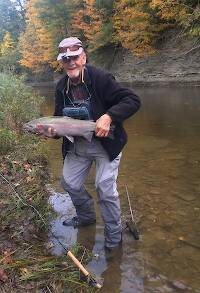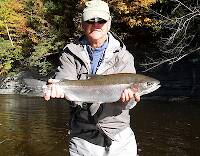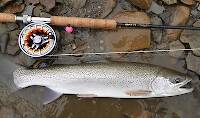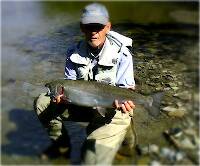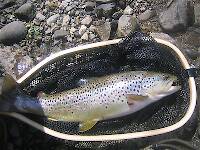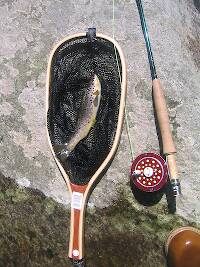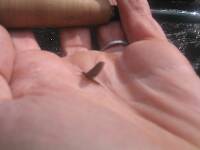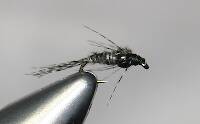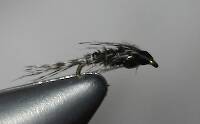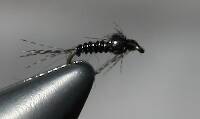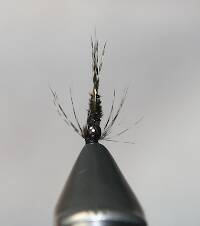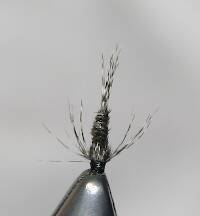
Salmonflies
Pteronarcys californica
The giant Salmonflies of the Western mountains are legendary for their proclivity to elicit consistent dry-fly action and ferocious strikes.
Featured on the forum

Nymphs of this species were fairly common in late-winter kick net samples from the upper Yakima River. Although I could not find a key to species of Zapada nymphs, a revision of the Nemouridae family by Baumann (1975) includes the following helpful sentence: "2 cervical gills on each side of midline, 1 arising inside and 1 outside of lateral cervical sclerites, usually single and elongate, sometimes constricted but with 3 or 4 branches arising beyond gill base in Zapada cinctipes." This specimen clearly has the branches and is within the range of that species.

Troutnut is a project started in 2003 by salmonid ecologist Jason "Troutnut" Neuswanger to help anglers and
fly tyers unabashedly embrace the entomological side of the sport. Learn more about Troutnut or
support the project for an enhanced experience here.
LittleJ on Nov 9, 2006November 9th, 2006, 9:00 am EST
Can any one help me out with some mayfly nymph patterns. I use a pheasant tail nymph (no bead) sizes 14-18 to cover most. I also use a specific Isonychia pattern in the fall. It seems to me that I should have a broader selection given all the different mayflys. Any help from those of you with a better understanding of the bug world than i would be appreciated.
Thanks
Jeff
Thanks
Jeff
Shawnny3 on Nov 9, 2006November 9th, 2006, 11:42 am EST
The Iso is a really nice nymph, and the pheasant tail will always produce something. A good first few, to be sure.
I wouldn't fish the Little J in May without a dark sulphur nymph (Flyfisher's Paradise's website has a nice, traditional tie) - the deadliest fly I know under the right conditions. And don't be fooled into thinking the pheasant tail is a good enough imitation - a big, fat, orangish/brown sulphur nymph with a prominent wingcase, tail, and legs is far better in my experience.
In summer, I wouldn't go without a fluorescent green worm - I tie my own version that's a bit strange, but the odious Green Weenie or a green San Juan Worm will do the trick much of the time.
I confess I'm not an expert on that river, but those two flies are musts for me when I'm on it.
In general, I would add to those a sowbug/muskrat, Walt's Worm or some other cream-colored caddis (and maybe light- and dark-olive versions if you want to be more thorough), an olive shrimp, and a wet black ant (summer). I know that every fly I've listed isn't a nymph per se, but they're all fished wet, so whatever.
I might do better if I only fished the above flies and nothing else, but I'm a tinkerer and enjoy the challenge of trying to catch fish on my own ties, not really caring much if I get my butt kicked with the newest thing I've whipped up at the bench. I'd say those half-dozen flies would carry you a long way, though, and they don't require advanced degrees to tie. A decent start.
-Shawn
P.S. Oh, and my sincere apologies to all the bug experts out there for polluting this esteemed forum with all those crude references to patterns and insects. Please be merciful - I'm a bad student.
I wouldn't fish the Little J in May without a dark sulphur nymph (Flyfisher's Paradise's website has a nice, traditional tie) - the deadliest fly I know under the right conditions. And don't be fooled into thinking the pheasant tail is a good enough imitation - a big, fat, orangish/brown sulphur nymph with a prominent wingcase, tail, and legs is far better in my experience.
In summer, I wouldn't go without a fluorescent green worm - I tie my own version that's a bit strange, but the odious Green Weenie or a green San Juan Worm will do the trick much of the time.
I confess I'm not an expert on that river, but those two flies are musts for me when I'm on it.
In general, I would add to those a sowbug/muskrat, Walt's Worm or some other cream-colored caddis (and maybe light- and dark-olive versions if you want to be more thorough), an olive shrimp, and a wet black ant (summer). I know that every fly I've listed isn't a nymph per se, but they're all fished wet, so whatever.
I might do better if I only fished the above flies and nothing else, but I'm a tinkerer and enjoy the challenge of trying to catch fish on my own ties, not really caring much if I get my butt kicked with the newest thing I've whipped up at the bench. I'd say those half-dozen flies would carry you a long way, though, and they don't require advanced degrees to tie. A decent start.
-Shawn
P.S. Oh, and my sincere apologies to all the bug experts out there for polluting this esteemed forum with all those crude references to patterns and insects. Please be merciful - I'm a bad student.
Jewelry-Quality Artistic Salmon Flies, by Shawn Davis
www.davisflydesigns.com
www.davisflydesigns.com
Softhackle on Nov 9, 2006November 9th, 2006, 1:27 pm EST
Hi,
You might look up a Gray Goose Nymph, brother to famed Pheasant Tail originally tied by the late Frank Sawyer. Also don't forget a Gold Ribbed Hare's Ear or a Flash Back Hare's Ear and a Brassy or Copper John.
Don't forget Zug Bug--
http://i12.photobucket.com/albums/a222/Soft-hackle/zugbugA.jpg
Have fun!
Mark
You might look up a Gray Goose Nymph, brother to famed Pheasant Tail originally tied by the late Frank Sawyer. Also don't forget a Gold Ribbed Hare's Ear or a Flash Back Hare's Ear and a Brassy or Copper John.
Don't forget Zug Bug--
http://i12.photobucket.com/albums/a222/Soft-hackle/zugbugA.jpg
Have fun!
Mark
"I have the highest respect for the skilled wet-fly fisherman, as he has mastered an art of very great difficulty." Edward R. Hewitt
Flymphs, Soft-hackles and Spiders: http://www.troutnut.com/libstudio/FS&S/index.html
Flymphs, Soft-hackles and Spiders: http://www.troutnut.com/libstudio/FS&S/index.html
LittleJ on Nov 9, 2006November 9th, 2006, 1:27 pm EST
Shawn,
Appreciate the advice. I could not find the sulpher pattern on the ffp website. I think i have an idea what it might look like, but a recipe (if it's not closely guarded) would be great. I feel i have a pretty good grasp on the caddis activity,(I'm assuming that is what you try to imitate w/ your green worm) that is primarily what i fish when i'm "nymphing". My personal favorite is a peeking caddis w/green larva. Similar to the grannoms(Brachycentrus?)that litter the bottom of the stream. I would like to know however, and maybe it should be the topic of another post, is what the scientific name is for the common tan caddis we have on the little j and spruce creek, and what color are the larva/pupae.
Jeff
Appreciate the advice. I could not find the sulpher pattern on the ffp website. I think i have an idea what it might look like, but a recipe (if it's not closely guarded) would be great. I feel i have a pretty good grasp on the caddis activity,(I'm assuming that is what you try to imitate w/ your green worm) that is primarily what i fish when i'm "nymphing". My personal favorite is a peeking caddis w/green larva. Similar to the grannoms(Brachycentrus?)that litter the bottom of the stream. I would like to know however, and maybe it should be the topic of another post, is what the scientific name is for the common tan caddis we have on the little j and spruce creek, and what color are the larva/pupae.
Jeff
GONZO on Nov 10, 2006November 10th, 2006, 2:57 am EST
Hi Jeff,
The "common tan caddis" you refer to are probably all Hydropsyche/Ceratopsyche spp. (Spotted Sedges). Among the most common PA species are Ceratopsyche bronta, morosa, sparna, and slossonae. The larvae are netspinners and are typically a dull olive-brown. The pupae range from greyish-tan to yellowish-brown, ginger, yellow, and even yellow-green. When in doubt, a yellow-brown imitation is a good general color for many Spotted Sedge emergences.
The "common tan caddis" you refer to are probably all Hydropsyche/Ceratopsyche spp. (Spotted Sedges). Among the most common PA species are Ceratopsyche bronta, morosa, sparna, and slossonae. The larvae are netspinners and are typically a dull olive-brown. The pupae range from greyish-tan to yellowish-brown, ginger, yellow, and even yellow-green. When in doubt, a yellow-brown imitation is a good general color for many Spotted Sedge emergences.
Martinlf on Nov 10, 2006November 10th, 2006, 8:15 am EST
Little J,
Shawn's advice is very good, so don't give up on the Flyfisher's Paradise website too soon. Along with others, I have had trouble finding things on it, but once you get used to it, it's a great reference. Try this: look for the Articles button at the bottom of their home page
http://www.flyfishersparadise.com/
click on the "Articles" button, and after you get on the Articles page, which has links to a few recent articles, go down to the bottom and click on the words "View the Archive." That will get you to all kinds of tying and fishing articles that are very helpful. The dark sulphur nymph pattern is there along with a host of Steve's other favorites and some helpful observations about fishing Spring Creek. For the dark sulphur nymph pattern, look at the top of the page once you are in archives, and you will see file folder type buttons; the one to click on is "Tying Patterns," then scroll down to "Nymphs." You'll see it. Click on "Dark Sulphur Nymph" for the pattern, a picture, and a discussion of sulphur nymphs in general. By the way, one sulphur cripple/emerger I saw on the J last season had an almost black shuck/case that it was struggling to get out of. It was much darker and more opaque that I had imagined shucks would be.
Also, information Gonzo has shared has led me to believe that I will in the future tie all my beadheads "in the round," including pheasant tails, which I like. See the Little Lehigh Flyshop website and its fly patterns for some (somewhat debatable) observations about flies in the round. As for PT's, Steve prefers the fur nymph, and I may move in that direction, but I've had good luck with BHPT's with a peacock thorax, and for now I'll use them but just omit the wingcase and be sure to tie the legs on the sides rather than beard style. That way the nymph will look right side up even if the bead turns it upside down, as I think it may. See Gonzo's book for more on this. See it also for some killer nymph patterns. Jason has a post on the book in another forum--take a look at his opinion on it. I concur with his comments.
Shawn's advice is very good, so don't give up on the Flyfisher's Paradise website too soon. Along with others, I have had trouble finding things on it, but once you get used to it, it's a great reference. Try this: look for the Articles button at the bottom of their home page
http://www.flyfishersparadise.com/
click on the "Articles" button, and after you get on the Articles page, which has links to a few recent articles, go down to the bottom and click on the words "View the Archive." That will get you to all kinds of tying and fishing articles that are very helpful. The dark sulphur nymph pattern is there along with a host of Steve's other favorites and some helpful observations about fishing Spring Creek. For the dark sulphur nymph pattern, look at the top of the page once you are in archives, and you will see file folder type buttons; the one to click on is "Tying Patterns," then scroll down to "Nymphs." You'll see it. Click on "Dark Sulphur Nymph" for the pattern, a picture, and a discussion of sulphur nymphs in general. By the way, one sulphur cripple/emerger I saw on the J last season had an almost black shuck/case that it was struggling to get out of. It was much darker and more opaque that I had imagined shucks would be.
Also, information Gonzo has shared has led me to believe that I will in the future tie all my beadheads "in the round," including pheasant tails, which I like. See the Little Lehigh Flyshop website and its fly patterns for some (somewhat debatable) observations about flies in the round. As for PT's, Steve prefers the fur nymph, and I may move in that direction, but I've had good luck with BHPT's with a peacock thorax, and for now I'll use them but just omit the wingcase and be sure to tie the legs on the sides rather than beard style. That way the nymph will look right side up even if the bead turns it upside down, as I think it may. See Gonzo's book for more on this. See it also for some killer nymph patterns. Jason has a post on the book in another forum--take a look at his opinion on it. I concur with his comments.
"He spread them a yard and a half. 'And every one that got away is this big.'"
--Fred Chappell
--Fred Chappell
Shawnny3 on Nov 10, 2006November 10th, 2006, 2:46 pm EST
One more fly I forgot to mention is a blue-winged olive nymph or emerger in size 18-20, both of which are nice year-round mayflies. I tie mine with an olive biot body and olive mallard wingcase over a gold bead, but less complicated ties are probably just as good. If you tie biot bodies, ribbing over the biot with a fine gold wire helps keep it from falling apart, as does laying a little cement onto the body before wrapping the biot. I like to carry these in both light and dark olive colors.
I can remember a day on Spring when a nice tan caddis hatch was coming off, and I just decided that I wasn't going to fish it and would fish BWOs instead, even though there weren't any coming off. I caught a pile of fish while others I talked to afterwards had been skunked. I've learned that there are very few situations in which a BWO won't catch fish. If you're into fishing multiple flies at once, it's a nice compliment to large nymphs like the sulphur or iso, especially if you fish one a foot or two deeper than the other.
-Shawn
I can remember a day on Spring when a nice tan caddis hatch was coming off, and I just decided that I wasn't going to fish it and would fish BWOs instead, even though there weren't any coming off. I caught a pile of fish while others I talked to afterwards had been skunked. I've learned that there are very few situations in which a BWO won't catch fish. If you're into fishing multiple flies at once, it's a nice compliment to large nymphs like the sulphur or iso, especially if you fish one a foot or two deeper than the other.
-Shawn
Jewelry-Quality Artistic Salmon Flies, by Shawn Davis
www.davisflydesigns.com
www.davisflydesigns.com
GONZO on Nov 10, 2006November 10th, 2006, 3:48 pm EST
Interesting observation, Shawn. I'm reminded that caddisflies (especially Spotted Sedges) are always most obvious to anglers during the deceptive pre-nuptial flights of the males. Even when rises are seen, they often have nothing to do with this activity. Perhaps you were matching the hatch without knowing it. Can't say if this was true of the situation you describe, but I've seen it happen just that way many times.
I concur about the general effectiveness of BWO nymphs. One reason is their omnipresent, multi-brooded nature (especially on limestoners). The other is that pressured fish are generally more susceptible to tiny flies. And, from an imitative standpoint, I like your use of the bead as a thorax rather than a head. (This puts the bulge in the appropriate place.)
On Louis's comment about the sulphur shuck--mayfly shucks are more substantial than caddisfly shucks. The shed exoskeleton of a mayfly looks much like the nymph; the caddisfly exoskeleton is more filmy and insubstantial. You can see a very good example of this on Jason's Brachycentrus appalachia page. Look at the underwater shot of the stillborn Hendrikson and the Apple Caddis shucks. See the difference?
I concur about the general effectiveness of BWO nymphs. One reason is their omnipresent, multi-brooded nature (especially on limestoners). The other is that pressured fish are generally more susceptible to tiny flies. And, from an imitative standpoint, I like your use of the bead as a thorax rather than a head. (This puts the bulge in the appropriate place.)
On Louis's comment about the sulphur shuck--mayfly shucks are more substantial than caddisfly shucks. The shed exoskeleton of a mayfly looks much like the nymph; the caddisfly exoskeleton is more filmy and insubstantial. You can see a very good example of this on Jason's Brachycentrus appalachia page. Look at the underwater shot of the stillborn Hendrikson and the Apple Caddis shucks. See the difference?
Martinlf on Nov 11, 2006November 11th, 2006, 3:12 am EST
Thanks guys. I'm learning much from these exchanges. Gonzo, those are great mayfly and caddis pictures. I wish I'd seen them years ago. The bug I saw on the J changed my attitude about shucks, and this confirms and extends the change. T think I'll tie shucks thicker for mayflies, and thinner for caddis from now on. On the biot bodies: I like them too, and put a (very) little gorilla glue (polyurethane glue) on the thread underbody before wrapping them. It expands a bit while curing and fills in the gaps nicely, bonding the biot to the hook. I've also brushed thin epoxy over the bodies to keep them from shredding, but I have mixed feelings about the results. I'll try gold wire, which I'd suppose would give a nice bit of flash too. Shawn, do you counter wrap it, as with a PT, or go over the spirals of the biot? Also what hook do you use? Gonzo has pointed out that beads tend to flip some hooks (or perhaps all of them) upside down. Could this in part be due to the down eye of the hook putting the weight of the bead below a line of stability created by the leader in relation to the hook shank (if I'm making any sense)? I've seen beadheads turn upside down, and am trying to find ways to use this information to learn how to tie bead flies either in the round (looking the same from all sides), or upside down. I wonder if the tendency to turn over is less pronounced in ring eye hooks--Gonzo? I'm also wondering if it's worthwhile to try to use weight on the top of the shank and tie the fly upside down on small beadhead flies such as the olive nymph Shawn describes to get a beadhead that flips over and has the wing case oriented up rather than down. Any thoughts Gonzo? Oh, two other questions for Shawn, is that a olive dyed mallard wing feaher you use for the case, or speckled flank feather? And, do you bother with legs? If so, what. OK, it was three questions.
"He spread them a yard and a half. 'And every one that got away is this big.'"
--Fred Chappell
--Fred Chappell
Shawnny3 on Nov 11, 2006November 11th, 2006, 1:05 pm EST
First, I've never had a problem with my beaded nymphs floating upside down, and I use down-eyed hooks - I'd be interested in hearing others' experiences with that. Possibly it has to do with the type of bead you buy. I might guess that beads with larger holes ridelower on the shank and thus keep the fly right-side-up? Also, perhaps using a heavier hook would help keep the fly upright.
When I wind wire over biots I wind it in the same direction as the biot, adding to the ribbing effect of the biot. Biots are slightly different shades on each side, so you can get two shades of flies from one strip of biots. I use regular dry-fly hooks (Tiemcos) because I'm too cheap to buy a lot of fancy hooks - they get pricey if you're buying decent ones, and it's much more important to have good quality hooks than a big variety. The mallard I was referring to is the speckled flank, and I would say every tier should have mallard flank in at least natural cream, natural golden, olive-dyed, and brown-dyed - phenomenal material for tails, legs, and wingcases.
When I tie in mallard for a wingcase, I attach about a dozen barbs by the middle of the barbs with a few hard wraps, measuring carefully so that the tips will become my legs (saves a step if you get the length just right). Then I half-hitch, push the bead back snug, and half-hitch in front of the bead, securing it in place by making a few hard turns (every turn I make when tying is hard, to be honest). Then I pull both the butts and tips of the mallard over the bead, tie it off with a few wraps at the head, and clip just the butts, not the tips. If I've been careful in my measurements, the tips can then be stroked back on either side of the bead and tied off, forming the legs without ever having to go through the maddening exercise of tying in two separate sets of legs. If you're going to mismeasure, let the tips be too long - you can always clip them shorter - they won't look as pretty to you, but they'll have a stronger profile in the water and the fish might actually see them better. Tying in slightly too many legs allows you to pull off any that misbehave or any extras - a lot easier than adding more after the fact. Finish the head and you're done. A word of caution to anyone wishing to follow this procedure: Plan more room for the head than usual. I don't think I've ever tied a fly with too much headroom, and I know I'm not alone. A somewhat large head on this fly not only preserves your sanity but also makes it more realistic looking by putting the bead in the thorax position (as Gonzo stated earlier) and making the legs look like they protrude from the proper place (funny, by looking at many flyshops' patterns, you'd think insects had 26 legs sticking out of their heads).
This fly is also nice in a grey color and a light brown. I've actually replaced many of these complicated biot ties in my flybox with a new and simpler pattern I've come up with, but I'll resist posting instructions for it as I hope to find a magazine editor dumb enough to publish them in return for a pittance.
Hope this helps.
-Shawn
When I wind wire over biots I wind it in the same direction as the biot, adding to the ribbing effect of the biot. Biots are slightly different shades on each side, so you can get two shades of flies from one strip of biots. I use regular dry-fly hooks (Tiemcos) because I'm too cheap to buy a lot of fancy hooks - they get pricey if you're buying decent ones, and it's much more important to have good quality hooks than a big variety. The mallard I was referring to is the speckled flank, and I would say every tier should have mallard flank in at least natural cream, natural golden, olive-dyed, and brown-dyed - phenomenal material for tails, legs, and wingcases.
When I tie in mallard for a wingcase, I attach about a dozen barbs by the middle of the barbs with a few hard wraps, measuring carefully so that the tips will become my legs (saves a step if you get the length just right). Then I half-hitch, push the bead back snug, and half-hitch in front of the bead, securing it in place by making a few hard turns (every turn I make when tying is hard, to be honest). Then I pull both the butts and tips of the mallard over the bead, tie it off with a few wraps at the head, and clip just the butts, not the tips. If I've been careful in my measurements, the tips can then be stroked back on either side of the bead and tied off, forming the legs without ever having to go through the maddening exercise of tying in two separate sets of legs. If you're going to mismeasure, let the tips be too long - you can always clip them shorter - they won't look as pretty to you, but they'll have a stronger profile in the water and the fish might actually see them better. Tying in slightly too many legs allows you to pull off any that misbehave or any extras - a lot easier than adding more after the fact. Finish the head and you're done. A word of caution to anyone wishing to follow this procedure: Plan more room for the head than usual. I don't think I've ever tied a fly with too much headroom, and I know I'm not alone. A somewhat large head on this fly not only preserves your sanity but also makes it more realistic looking by putting the bead in the thorax position (as Gonzo stated earlier) and making the legs look like they protrude from the proper place (funny, by looking at many flyshops' patterns, you'd think insects had 26 legs sticking out of their heads).
This fly is also nice in a grey color and a light brown. I've actually replaced many of these complicated biot ties in my flybox with a new and simpler pattern I've come up with, but I'll resist posting instructions for it as I hope to find a magazine editor dumb enough to publish them in return for a pittance.
Hope this helps.
-Shawn
Jewelry-Quality Artistic Salmon Flies, by Shawn Davis
www.davisflydesigns.com
www.davisflydesigns.com
Taxon on Nov 11, 2006November 11th, 2006, 5:28 pm EST
Anyone-
This is one of those questions that I'm really fearful of asking. However, "fools rush in where angels fear to tread." So, what does tying "in the round" mean? Have been tying flies for 25 years, and can't remember having previously heard that expression. On the other hand, the sun had already set today before I realized it was Saturday and not Friday.
This is one of those questions that I'm really fearful of asking. However, "fools rush in where angels fear to tread." So, what does tying "in the round" mean? Have been tying flies for 25 years, and can't remember having previously heard that expression. On the other hand, the sun had already set today before I realized it was Saturday and not Friday.
JAD on Nov 12, 2006November 12th, 2006, 1:44 am EST
That had me going to :)
(Little Lehigh Flyshop website)
http://www.littlelehighflyshop.com/generic3.html
Quote------- #2 They look the same from all directiions.
Real flies don't tumble. Your imitation does. Wild fish aren't used to seeing
the stomach of a bug, then the side, then the top.
I believe flies that look the same from all sides reduce this problen.
Remember, all wild fish want to see is whats normal.
JaD
They fasten red (crimson red) wool around a hook, and fix onto the wool two feathers which grow under a cock’s wattles, and which in colour are like wax.
Radcliffe's Fishing from the Earliest Times,
Shawnny3 on Nov 12, 2006November 12th, 2006, 4:21 am EST
Tying "in the round" is a technique developed by Charlie Brooks. Effectively, you determine which viewing angle presents the strongest profile of a particular nymph, then you tie the fly with a rotational symmetry so that it has that same strong profile when you rotate it. Usually, this means tying nymphs with bushy tails, fat bodies, and lots of hackle. Probably his most famous tie is the Montana Stone, but for a good picture of another example, check out
http://www.fedflyfishers.org/FlyOfMonth/beadbrooksstone.htm.
That should give you a good idea as to the basic technique. I personally do not tie many flies in the round, but it makes good sense and many fishermen swear by them.
I am not a flyfishing historian by any means, but I like to attribute things to the right people when possible - I think it's important to give credit where it is due.
-Shawn
http://www.fedflyfishers.org/FlyOfMonth/beadbrooksstone.htm.
That should give you a good idea as to the basic technique. I personally do not tie many flies in the round, but it makes good sense and many fishermen swear by them.
I am not a flyfishing historian by any means, but I like to attribute things to the right people when possible - I think it's important to give credit where it is due.
-Shawn
Jewelry-Quality Artistic Salmon Flies, by Shawn Davis
www.davisflydesigns.com
www.davisflydesigns.com
GONZO on Nov 12, 2006November 12th, 2006, 4:53 am EST
Roger and JaD,
I'm not sure who originated the expression "tying in-the-round," but we are all familiar with very successful flies that are tied that way--simple soft-hackles, Woolly Worms, Woolly Buggers, San Juan Worms, etc. I first became aquainted with the practice as a tying philosophy through the writings of Charlie Brooks (Nymph Fishing for Larger Trout). The Brooks Stone would be one of the better known examples of his philosophy.
Contrary to the quotation above, "real flies" do tumble if the turbulence is sufficient to overwhelm their natural orientation. The general sentiment is correct, however. Tying in-the-round is a practical solution for simple flies or ones where maintaining natural orientation is difficult (such as many beadheads).
Such tying does place limitations on how accurate an imitation of certain insects/prey can be. And it doesn't necessarily address the problem of prey that display dramatically different colors or appearance depending upon whether the trout views them from above or below. With more accurate or detailed imitations, the problem of proper orientation should be addressed. (Or the attempt to achieve a particular effect could be wasted or subverted.) My general rule is to place buoyant materials above the midline and heavier materials (or weight) below to achieve the intended posture in the water.
In our American rush to modify every standard underwater pattern by adding a bright bulbous bead to the head, we've produced many flies that roll over and die in the water. These flies might still catch fish, but probably not for the reasons we imagine.
I have suggested elsewhere that every tier should have a glass of water at their tying table in order to perform a basic test of orientation (with dries or wets). Whether you are testing a new design or evaluating existing "commercial" flies, this simple test can be revealing--just drop the fly in and watch what happens. While there are other issues that influence orientation (such as drag or laminar flow over surfaces, as in the case of flies moving against the water), the "water test" can head off a lot of frustration and produce a better understanding of some important (and often overlooked) aspects of fly design.
PS--Sorry Shawn, looks like we were in IM mode. But I'm sure that Charlie wouldn't mind receiving double credit. :)
PPS--Louis, using a bead and a curved hook ("caddis pupa" or "scud" hook) almost guarantees an upside-down drift, unless some very buoyant material is placed on top. This should be a good starting place for designing your inverted beadheads. The upward curve of the abdomen produced by such a tie is also imitative of the drifting posture of many mayfly nymphs. (Unfortunately, many commercial patterns do just the opposite.)
I'm not sure who originated the expression "tying in-the-round," but we are all familiar with very successful flies that are tied that way--simple soft-hackles, Woolly Worms, Woolly Buggers, San Juan Worms, etc. I first became aquainted with the practice as a tying philosophy through the writings of Charlie Brooks (Nymph Fishing for Larger Trout). The Brooks Stone would be one of the better known examples of his philosophy.
Contrary to the quotation above, "real flies" do tumble if the turbulence is sufficient to overwhelm their natural orientation. The general sentiment is correct, however. Tying in-the-round is a practical solution for simple flies or ones where maintaining natural orientation is difficult (such as many beadheads).
Such tying does place limitations on how accurate an imitation of certain insects/prey can be. And it doesn't necessarily address the problem of prey that display dramatically different colors or appearance depending upon whether the trout views them from above or below. With more accurate or detailed imitations, the problem of proper orientation should be addressed. (Or the attempt to achieve a particular effect could be wasted or subverted.) My general rule is to place buoyant materials above the midline and heavier materials (or weight) below to achieve the intended posture in the water.
In our American rush to modify every standard underwater pattern by adding a bright bulbous bead to the head, we've produced many flies that roll over and die in the water. These flies might still catch fish, but probably not for the reasons we imagine.
I have suggested elsewhere that every tier should have a glass of water at their tying table in order to perform a basic test of orientation (with dries or wets). Whether you are testing a new design or evaluating existing "commercial" flies, this simple test can be revealing--just drop the fly in and watch what happens. While there are other issues that influence orientation (such as drag or laminar flow over surfaces, as in the case of flies moving against the water), the "water test" can head off a lot of frustration and produce a better understanding of some important (and often overlooked) aspects of fly design.
PS--Sorry Shawn, looks like we were in IM mode. But I'm sure that Charlie wouldn't mind receiving double credit. :)
PPS--Louis, using a bead and a curved hook ("caddis pupa" or "scud" hook) almost guarantees an upside-down drift, unless some very buoyant material is placed on top. This should be a good starting place for designing your inverted beadheads. The upward curve of the abdomen produced by such a tie is also imitative of the drifting posture of many mayfly nymphs. (Unfortunately, many commercial patterns do just the opposite.)
Martinlf on Nov 12, 2006November 12th, 2006, 5:31 am EST
Shawn, thanks for the directions. I do have mallard flank, dyed just as you describe, that I use from time to time in different applications.
Gonzo, I'm also wondering if it's worthwhile to try to use weight on the top of the shank and then turn the hook over and tie the fly upside down on small beadhead flies such as the olive nymph Shawn describes to get a beadhead that flips over and has the wing case oriented up rather than down. Or would placing the bead farther back reduce the turn over? Any thoughts?
OK, I'm filling the glass of water now.
Gonzo, I'm also wondering if it's worthwhile to try to use weight on the top of the shank and then turn the hook over and tie the fly upside down on small beadhead flies such as the olive nymph Shawn describes to get a beadhead that flips over and has the wing case oriented up rather than down. Or would placing the bead farther back reduce the turn over? Any thoughts?
OK, I'm filling the glass of water now.
"He spread them a yard and a half. 'And every one that got away is this big.'"
--Fred Chappell
--Fred Chappell
Shawnny3 on Nov 12, 2006November 12th, 2006, 5:56 am EST
Very good suggestions, Gonzo - I really like the idea of the upside-down mayfly tie - could be very realistic.
To add to Gonzo's suggestion about the glass of water, you might also want to try using a coffee mug or putting a white background behind your glass as you look at it. Doing so will not only give you a good idea as to how your fly orients but also what its color will be when fished. Most tiers tie flies the wrong color because they never take the time to see what it looks like wet. All fibers get darker when wet, natural fibers getting much darker than synthetics. But don't think that spitting on the fly at the vise is good enough to judge color (or any other aspect of appearance), because the appearance changes dramatically when the fly is actually immersed in water. I like to fill my ceramic bathroom sink with water and throw my new ties into it, allowing them to get nice and soaked before I conclude whether I've gotten the color right. Then, I swirl the water in the sink with my fingers to see how the fly tumbles, how quickly it reorients itself (if at all), how fast it sinks... a lot of important things to know. Of course, these properties change once a fly is attached to a leader, but it's at least a good start. When I'm developing or learning a new pattern, I do this after each prototype until I get it right. Sometimes it takes a dozen flies before I get the color right. But once I do, I can blend up a pile of dubbing that color and be set for life.
Poor Jason, trying to decide where these threads belong. It's so easy for them to spiral out of control...
-Shawn
To add to Gonzo's suggestion about the glass of water, you might also want to try using a coffee mug or putting a white background behind your glass as you look at it. Doing so will not only give you a good idea as to how your fly orients but also what its color will be when fished. Most tiers tie flies the wrong color because they never take the time to see what it looks like wet. All fibers get darker when wet, natural fibers getting much darker than synthetics. But don't think that spitting on the fly at the vise is good enough to judge color (or any other aspect of appearance), because the appearance changes dramatically when the fly is actually immersed in water. I like to fill my ceramic bathroom sink with water and throw my new ties into it, allowing them to get nice and soaked before I conclude whether I've gotten the color right. Then, I swirl the water in the sink with my fingers to see how the fly tumbles, how quickly it reorients itself (if at all), how fast it sinks... a lot of important things to know. Of course, these properties change once a fly is attached to a leader, but it's at least a good start. When I'm developing or learning a new pattern, I do this after each prototype until I get it right. Sometimes it takes a dozen flies before I get the color right. But once I do, I can blend up a pile of dubbing that color and be set for life.
Poor Jason, trying to decide where these threads belong. It's so easy for them to spiral out of control...
-Shawn
Jewelry-Quality Artistic Salmon Flies, by Shawn Davis
www.davisflydesigns.com
www.davisflydesigns.com
GONZO on Nov 12, 2006November 12th, 2006, 6:34 am EST
Ditto, Shawn--I love it! Your comment about the bathroom sink brought me back to my youth--my mother used to holler at me for filling up the bathtub in order to test my flies (some with leaders attached)!! :)
Louis, it should work, but the influence of the materials is the unknown quantity. The water-test will tell.
And I, too, sympathize with poor Jason trying to sort out all these "loose threads." But that's what he gets for attracting such a creative and enthusiastic usergroup!
Louis, it should work, but the influence of the materials is the unknown quantity. The water-test will tell.
And I, too, sympathize with poor Jason trying to sort out all these "loose threads." But that's what he gets for attracting such a creative and enthusiastic usergroup!
LittleJ on Nov 12, 2006November 12th, 2006, 1:56 pm EST
I usually don't use beads on nymphs mainly because i feel the fish see to many of them on the often crowded local streams.(little juniata, spruce creek) That being said i like to weight nymphs w/ a lead under body to avoid split shot as much as possible, and have tried in the past to weight them with just a single strip on the underside of the hook, to possibly correct the drift. In my experience with them I saw no real big improvement. Sure i caught fish on them but i caught fish before as well.
My tying method could have been flawed, and my experiment surely wasn't scientific. However, my guess would be that the upside down fly would not be any more effective, give it a shot though I'm interested to know the results of your trial. Hope to have helped.
Jeff
My tying method could have been flawed, and my experiment surely wasn't scientific. However, my guess would be that the upside down fly would not be any more effective, give it a shot though I'm interested to know the results of your trial. Hope to have helped.
Jeff
Martinlf on Nov 14, 2006November 14th, 2006, 3:33 am EST
Ok, Gonzo and Jeff have me almost ready to abandon the bead heads on mayfly nymphs--or at least to wean myself from them in some situations. A very memorable day with gold BHPT's on Spring Creek a few years back during the sulphur hatch will make this a hard habit to break, though, and looking back now I see Gonzo offered an idea about an upside down beadhead on a scud hook. I have wondered if the beads look like the bulge of an emerging fly or that of a swelling thorax to some fish. One guy I know only uses black beads, perhaps with this possibility in mind. I even thought about trying light yellow beads for sulphur nymphs at one time (if they even exist), since some folks use a half and half brown abdomen, yellow thorax nymph during the sulphur emergence. I'll probably experiment some with the bead, curved hook combo Gonzo mentions just to see. Perhaps it will give the fish something new to laugh at.
"He spread them a yard and a half. 'And every one that got away is this big.'"
--Fred Chappell
--Fred Chappell
Jlh42581 on Jan 2, 2007January 2nd, 2007, 9:04 am EST
Buy
Hatch Guide For New England Streams by Thomas Ames Jr
It shows every nymph and adult insect that you ever need to know for this area of the US.
Hatch Guide For New England Streams by Thomas Ames Jr
It shows every nymph and adult insect that you ever need to know for this area of the US.
Jeremy
Quick Reply
Related Discussions
Topic
Replies
Last Reply
0
May 6, 2011
by Jtberez
by Jtberez
2
Mar 24, 2011
by CaseyP
by CaseyP
1
May 11, 2007
by Troutnut
by Troutnut






